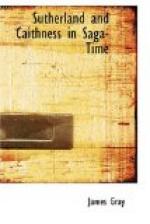The other moiety of the Caithness earldom lands would be fairly given to Johanna as heiress of Ragnhild, Harald Ungi’s youngest sister, and we know that Johanna got that other moiety, because we find that her descendants inherited it, and conveyed it or parts of it by writs still extant, by the description of “half Caithness.”
There are, however, other views. Skene’s opinion on the subject of the succession, in his very able paper (given in Appendix V, vol. iii, pp. 449-50 of his Celtic Scotland), is as follows:—
“Earl Harald died in 1206, and was succeeded by his son David, who died in 1214, when his brother John became Earl of Orkney and Caithness. Fordun tells us that King William made a treaty of peace with him in that year, and took his daughter as a hostage, but the burning of Bishop Adam in 1222 brought King Alexander II down upon Earl John, who was obliged to give up part of his lands into the hands of the king, which, however, he redeemed the following year by paying a large sum of money, and by his death in 1231 the line of Paul again came to an end.
“In 1232, we find Magnus, son of Gillebride, Earl of Angus, called Earl of Caithness, and the earldom remained in this family till between 1320 and 1329, when Magnus Earl of Orkney and Caithness, died; but during this time it is clear that these earls only possessed one half of Caithness and the other half appears in the possession of the De Moravia family, for Freskin, Lord of Duffus, who married Johanna, who possessed Strathnaver in her own right, and died before 1269, had two daughters, Mary, married to Sir Reginald Cheyne, and Christian, married to William de Fedrett; and each of these daughters had one fourth part of Caithness, for William de Fedrett resigns[11] his fourth to Sir Reginald Cheyne,[12] who then appears in possession of one-half of Caithness (Chart. of Moray; Robertson’s Index). These daughters probably inherited the half of Caithness through their mother Johanna. Gillebride[13] having called one of his sons by the Norwegian name of Magnus, indicates that he had a Norwegian mother. This is clear from his also becoming Earl of Orkney, which the king of Scots could not have given him. Gillebride died in[14] 1200, so that Magnus must have been born before that date, and about the time of Earl Harald Ungi, who had half of Caithness, and died in 1198. Magnus is a name peculiar to this line, as the great Earl Magnus belonged to it, and Harald Ungi had a brother Magnus. The probability is that the half of Caithness which belonged to the Angus family was that half usually possessed by the earls of the line of Erlend,[15] and was given by King Alexander with the title of Earl to Magnus, as the son of one of Earl Harald Ungi’s sisters, while Johanna, through whom the Moray family inherited the other half, was, as indicated by her name, the daughter of John, Earl of Caithness of the line of Paul, who had been kept by the king as a hostage, and given in marriage to Freskin de Moravia.”




